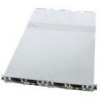Intel SR1680MV Service Guide - Page 79
BIOS Setup and Configuration, BIOS Setup Utility - bios update
 |
UPC - 735858210447
View all Intel SR1680MV manuals
Add to My Manuals
Save this manual to your list of manuals |
Page 79 highlights
5 BIOS Setup and Configuration This section describes the BIOS Setup Utility options. You can run the BIOS setup with or without an operating system present. Onboard devices are configured with the BIOS Setup utility that is embedded in flash ROM. The configuration utilities allow you to modify the CMOS RAM and NVRAM. The actual hardware configuration is accomplished by the BIOS POST routines and the BIOS PlugN-Play auto-configuration manager. The configuration utilities update a checksum for both areas, so potential data corruption is detected by the BIOS before the hardware configuration is saved. If the data is corrupted, the BIOS requests that the user reconfigure the system and reboot. Note: Because the BIOS code is the most often changed part of the server board design, the BIOS information described in this section may be a little different compared to the actual BIOS that contained in your server board. BIOS Setup Utility This section describes the ROM-resident setup utility that provides the means to configure the platform. The BIOS Setup utility is part of the system BIOS and allows limited control over onboard resources. The user can disable embedded PCI devices through the setup menus. When these devices are disabled through setup, their resources are freed. Note: The BIOS options described in this section may or may not be present in pre-production versions of the system BIOS. This section describes the BIOS utility as it is planned to be at production and is subject to change. Option locations, in a given menu of the BIOS Setup utility as described in this section, may be different from those observed on any one pre-production version of the system BIOS. The BIOS Setup utility screen is divided into four functional areas. Table 5. BIOS Setup Utility Screen Descriptions Functional Area Keyboard Command Bar Menu Selection Bar Description Located at the bottom of the right screen or as part of the help screen. This bar displays the keyboard commands supported by the setup utility. Located at the top of the screen. Displays the various major menu selections available to the user. The Server Setup utility major menus are: Main Menu, Advanced Menu, Boot Menu, Security Menu, and Exit Menu. Intel® Server System SR1680MV Service Guide 59















